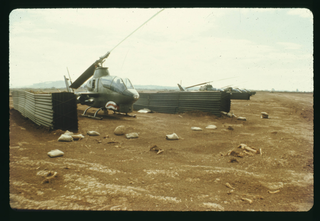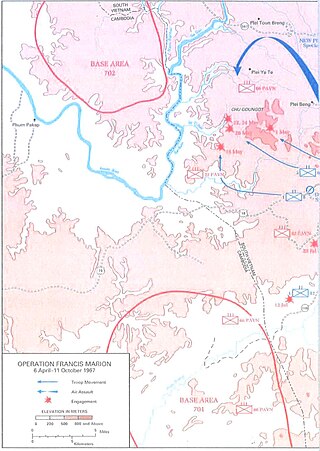
The battle of Dak To in Vietnam was a series of major engagements of the Vietnam War that took place between 3 and 23 November 1967, in Kon Tum Province, in the Central Highlands of the Republic of Vietnam. The action at Đắk Tô was one of a series of People's Army of Vietnam (PAVN) offensive initiatives that began during the second half of the year. PAVN attacks at Lộc Ninh, Sông Bé and at Con Thien and Khe Sanh,, were other actions which, combined with Đắk Tô, became known as "the border battles". The post hoc purported objective of the PAVN forces was to distract American and South Vietnamese forces away from cities towards the borders in preparation for the Tet Offensive.

The 1975 spring offensive, officially known as the general offensive and uprising of spring 1975, was the final North Vietnamese campaign in the Vietnam War that led to the capitulation of Republic of Vietnam. After the initial success capturing Phước Long Province, the North Vietnamese leadership increased the scope of the People's Army of Vietnam's (PAVN) offensive and captured and held the key Central Highlands city of Buôn Ma Thuột between 10 and 18 March. These operations were intended to be preparatory to launching a general offensive in 1976.

The Battle of Ban Me Thuot was a decisive battle of the Vietnam War which led to the complete destruction of South Vietnam's II Corps Tactical Zone. The battle was part of a larger North Vietnamese military operation known as Campaign 275 to capture the Tay Nguyen region, known in the West as the Vietnamese Central Highlands.

The Vietnamese Rangers (Vietnamese: Biệt Động Quân; Chữ Hán: 別動軍), commonly known as the ARVN Rangers or Vietnamese Ranger Corp (VNRC), were the light infantry of the Army of the Republic of Vietnam. Trained and assisted by American Special Forces and Ranger advisers, the Vietnamese Rangers infiltrated beyond enemy lines in search and destroy missions. Initially trained as a counter-insurgency light infantry force by removing the fourth company each of the existing infantry battalions, they later expanded into a swing force capable of conventional as well as counter-insurgency operations, and were relied on to retake captured regions. Later during Vietnamization the Civilian Irregular Defense Group program was transferred from MACV and integrated as Border Battalions responsible for manning remote outposts in the Central Highlands.

Phase Two of the Tet Offensive of 1968 was launched by the People's Army of Vietnam (PAVN) and Viet Cong (VC) against targets throughout South Vietnam, including Saigon from 29 April to 30 May 1968. The May Offensive was considered much bloodier than the initial phase of the Tet Offensive. U.S. casualties across South Vietnam were 2,169 killed for the entire month of May, making it the deadliest month of the entire Vietnam War for U.S. forces, while South Vietnamese losses were 2,054 killed. PAVN/VC losses exceeded 24,000 killed and over 2,000 captured. The May Offensive was a costly defeat for the PAVN/VC.

The 23rd Division of the Army of the Republic of Vietnam (ARVN)—the army of the nation state of South Vietnam that existed from 1955 to 1975—was part of the II Corps that oversaw the Central Highlands.

The 22nd Division of the Army of the Republic of Vietnam (ARVN) was part of the II Corps that oversaw the region of the Central Highlands north of the capital Saigon. The 22nd Division was based in Ba Gi near the south central coast.
Đức Cơ Camp is a former U.S. Army and Army of the Republic of Vietnam (ARVN) base west of Pleiku in Gia Lai Province, central Vietnam.
The Battle of Thượng Ðức was a battle of the Vietnam War which began on 29 July and concluded on 11 November 1974.

Ban Me Thuot East Airfield was a military and civilian airfield and army base located approximately 8 km southeast of Buôn Ma Thuột.

Duc Lap Camp is a former U.S. Army and Army of the Republic of Vietnam (ARVN) base southwest of Buôn Ma Thuột in the Central Highlands of Vietnam.

Operation Francis Marion was a 4th Infantry Division and 173rd Airborne Brigade operation that took place in Pleiku, Darlac and Kon Tum Provinces, South Vietnam, lasting from 6 April to 11 October 1967.
Operation Shenandoah II was a security operation conducted during the Vietnam War by the U.S. 1st Infantry Division to secure and repair Highway 13, South Vietnam from 29 September to 19 November 1967.
Phase III of the Tet offensive of 1968 was launched by the People's Army of Vietnam (PAVN) and Viet Cong (VC) from 17 August to 27 September 1968. The offensive was divided into two waves of attacks from 17 to 31 August 1968 and from 11 to 27 September of that same year.
The War of the flags was a phase of fighting throughout South Vietnam lasting from 23 January to 3 February 1973 as the forces of North and South Vietnam each sought to maximize the territory under their control before the ceasefire in place agreed by the Paris Peace Accords came into effect on 27 January 1973. The fighting continued past the ceasefire date and into early February. South Vietnamese forces made greater territorial gains and inflicted significant losses on the North Vietnamese forces.
The Battle of Quang Duc took place from 30 October to 10 December 1973 when North Vietnamese forces attempted to occupy part of Quang Duc Province to expand their logistical network from Cambodia into South Vietnam. While the North Vietnamese attacks were initially successful they were eventually forced out by the South Vietnamese.
The Battle of Duc Duc took place from 18 July to 4 October 1974 in Duc Duc District, Quảng Nam Province. The North Vietnamese made some minor territorial gains and suffered heavy losses, while South Vietnamese forces were severely weakened by the fighting.
The 10th Infantry Division is a division of the People's Army of Vietnam (PAVN), first formed in September 1972.

Bù Đốp Camp is a former U.S. Army and Army of the Republic of Vietnam (ARVN) base in Bù Đốp District, Bình Phước Province near the Vietnam-Cambodia border.
Operation MacArthur was a United States Army military operation in the Central Highlands of South Vietnam from 12 October 1967 to 31 January 1969. The early phases of the operation encompassed the Battle of Dak To from 3 to 23 November 1967.










